List of political parties in Tengaria
This article lists political parties in Tengaria.
Parties with representation in the Grand Assembly
Legally, all political parties have been banned in Tengaria since 1958. However, there are several political organizations which exist which de facto function as political parties, although they do not bear the name. Most outside sources include the anti-partisan Patriotic Union as one of these, although the members of it disagree.
| Years Active |
Party name | Leader | Seats in the State Council |
Seats in the Chamber of Deputies |
Tengarian Seats in Mizparl |
Ideology | Position |
|---|---|---|---|---|---|---|---|
| 1956- | Patriotic Union | Teodora Kovacheva | 32 / 95 |
330 / 380 |
60 / 60 |
Nonpartisanism, Cultural nationalism, Social Conservatism | Right-wing |
| 1984- | Democratic Front | Todor Vilovon | 0 / 95 |
12 / 380 |
0 / 60 |
Pluralism, Pro-Eucleanism, Free-market | Centre |
| 1997- | Social Reform Front | Natalia Draganeva | 0 / 95 |
5 / 380 |
0 / 60 |
Social democracy, Social liberalism | Centre-left |
Defunct Parties
After the Euclean Spring, political societies and parties began to gradually form within Tengaria. Many of these associations were in support of increased liberalism, but did not have any representation in any kind of legislature. After the Green Revolution of 1868, Emperor Simeon III reformed the Senate and created the office of Minister-President. For the first four decades of the assembly, the Senate was non-partisan and its members independent politicians. However, in the late 1890s, parties first began to centralize from various factions within the Assembly and government, leading to the creation of Tengaria's first political parties. Explicitly pro-republican or anti-monarchy parties were banned, although several parties existed which were nominally pro-monarchy to ensure seats in the Senate.
The first two decades of the Tengarian Republic were extremely volatile. As a Presidential Republic, only during its first five years did the party of the President coincide with the majority in the Senate. The partial collapse of the TNVP saw the contest for power between 4 major and 3 minor parties, leading to very shaky coalitions and political deadlock as the economy continued to deteriorate. By 1955 the tensions had blown over after the election of a pro-monarchist President and the first majority in years led to the declaration of the People's Republic of Tengaria and the beginning of the Tengarian Civil War.
| Party logo | Party name | Ab. | First leader | Last leader | Year formed | Year dissolved | Ideology | |
|---|---|---|---|---|---|---|---|---|
| Republicans Републиканци |
RD РД |
 Boris Vladimerev |
 Nedelcho Dimov |
1862 | 1933 | |||
| Rather than an official political party, it was more a general fringe movement, promoting the abolition of the monarchy, dropping the Solarian identity in favour of a new "Tengarian" identity, the forced assimilation of minority groups, The Republicans were inspired by the First Soravian Civil War as well as movements in Eastern Euclea. Despite being outlawed, minor groups would continue to exist after they were defeated in the Green Revolution.. Republicans would be very prominent in the collaborationist Tengarian State, before effectively securing victory due to the forced imposition of a republic by Soravia after the war. Many of the republicans would largely join the Progressive Party, People's Party, or to the newly established Republican Party. Many of their nationalistic ideas would be adopted by the Tengarian Republic. | ||||||||
| File:Ukrainskiy-flag.gif | Constitutionalist Party Конституционалистическа Партия |
KP КП |
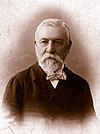 Borislav Tsvetanev |
 Gregori Ervo |
1896 | 1935 | ||
| Although on more on the right-wing of the political spectrum, being generally centre-right to centre in the estimation of other countries the KP were the effective left-wing and primary opposition party to the VS during the Imperial era. | ||||||||

|
All-Solarian Union TBD Всесолариански Съюз |
VS ВС |
 Krasimir Radkov |
 Simeon Radez |
1897 | 1957 |
| |
| The dominant party of the Imperial Period, which held a majority in the Chamber of Deputies for nearly every legislature. Several Minister-Presidents were members of the Union. The new authorities of the Republic tried to undermine the old authority of the reactionary VS, which saw it decline over the years, before becoming more prominent after the failures of the left to form a stable government, sweeping the 1955 elections which would set off the Tengarian Civil War. Became the largest portion of the Patriotic Union. | ||||||||
| Tengarian Section of the Worker's Internationale Тенгарска Секция на Работническия Интернационал |
TSMR ТСMР |
 Spas Milanev |
 Vladimir Vasilov |
1901 | 1956 | |||
| Part of the Congress of the Workers' International. | ||||||||

|
Progressive Party Прогресивна Партия |
PP ПП |
 Kiril Ilianev |
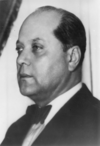 Nikolay Asenev |
1903 | 1955 | ||
| Split away from the Constitutionalists in 1903, comprised of the more liberal members of the KP. One of the parties to survive relatively intact into the transition, it was the prominent party on the left-wing until its influence began to decline in the late 1940s. | ||||||||
| Social Democratic Labour Party Социалдемократическа Лейбъристка Партия |
SLP СЛП |
 Anton Biserev |
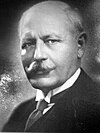 Ivan Hrstov |
1903 | 1935 | |||
| Generally more moderate the TSMR, the SLP was officially pro-monarchy while advocating for reform from within the Senate, as anti-monarchical parties were banned. Some members only nominally supported the monarchy, while others were monarcho-socialists. Had ties to the trade unions. | ||||||||
| Tengarian Nationalist and Revivalist Party Тенгарска Националистическа и Ръзрожденска Партия |
TNVP ТНРП |
 Kostadin Kirilev |
1922 | 1956 | ||||
| Tengarian version of the ZNVP. Supported nationalism, which was opposed to the Solarianism of the VS and which was associated with Republicanism (although during the monarchy it proclaimed loyalty to it). Notable for being anti-minority and pro assimilationist. Although positioned in the centre historically, it has since been considered as right-wing. When the Republic was established, the TNVP went from being a centre party to one of the right wing parties because of its opposition to socialism, although it was known to cross the aisle to support pro-nationalistic measures. | ||||||||

|
National Salvation Front Фронт за национално спасение |
FNS ФНС |
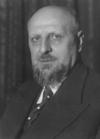 Genadi Grozdanev |
 Dragomir Raykov |
1926 | 1952 | ||
| Considered as left-wing under the Empire, and barred from holding office in the Senate. Joined the Republicans to support the Tengarian State in support of the Amathian occupation. Although suppressed by Simeon Kovachev for their role in collaboration after the Great War, under the Republic the Front returned for the 1940 elections. Lost all seats in the Senate by 1950, and collapsed as a party. | ||||||||

|
Tengarian People's Party Тенгарска Народна Партия |
TNP ТНП |
 Gregori Ervo |
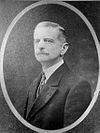 Valentin Georgiev |
1935 | 1957 | ||
| The primary successor to the Constitutionalist Party and a driving force in the establishment of the Republic, it was the major swing party between left and right and the most successful party at the first elections, and allied with the PP and the left-wing. However, began to support the right more as the PP began to push it out of government. | ||||||||
| Republican Party Републиканц Партия |
RP РП |
 Krum Angelov |
1935 | 1955 | ||||
| The nominal successor to the Republican movement, this party struggled at first due to the association of it with the Amathian Occupation, but later rose to prominence when it became a driving force behind the Popular Front in 1955. | ||||||||

|
Episemialist Democratic Party Еписемиалистическа Демократична Партия |
EDP ЕДП |
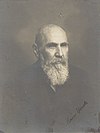 Lyubomir Borisev |
1935 | 1956 | |||
| Formed from the right-wing of the Constitutionalists and some old members of the VS, the EDP was an integral supporter in the right's coalition, and drew support on the religiously conservative populace. | ||||||||
| Farmer and Worker Union Земеделски и Работнически Съюз |
ZRS ЗРС |
 Ivan Hrstov |
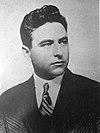 Mihail Ivanev |
1935 | 1955 | |||
| This party was seen as the principal successor to the SLP, and represented labour unions throughout the country. It was close allies with the TSMR, although it preferred democratic socialism to councilism. | ||||||||
| Social Democratic Party Социалдемократическа Партия |
SP СП |
 Zlatko Blagunev |
1935 | 1955 | ||||
| Split off from the more moderate wing of the old SLP, the SP was formed of the more moderate social democrats, but only really functioned as an important coalition partner, and its leader would serve as Minister-President 5 times. | ||||||||
| Agrarian Union Земеделски Съюз |
ZS ЗС |
 Milen Dafov |
1940 | 1956 | ||||
| Formed by the agrarians who were opposed to socialism and thus to the ZRS. Although centrist in nature, usually allied with the right-wing more often than not. | ||||||||
| Armonian-Calian Alliance Армониан-Калиански Алианс |
AKA AКA |
 Ioăn Pestrhistĭ |
 Béla Oláh |
1940 | 1950 | |||
| Due to the rise of nationalism with the advent of the Republic, the Armonian-Calian Alliance was formed to represent minority interests. They were closely aligned with the VS, and merged with them for the 1950 elections. | ||||||||

|
Popular Front Народен фронт |
NF НФ |
 Vladimir Vasilov |
1955 | 1956 | |||
| Merger of the RP, ZRS, SP, PP and many of the TSMR in opposition to the growing strength of the VS for the 1955 elections. The driving political force behind the Republican side in the Tengarian Civil War. Also sometimes known as the "Republicans". | ||||||||